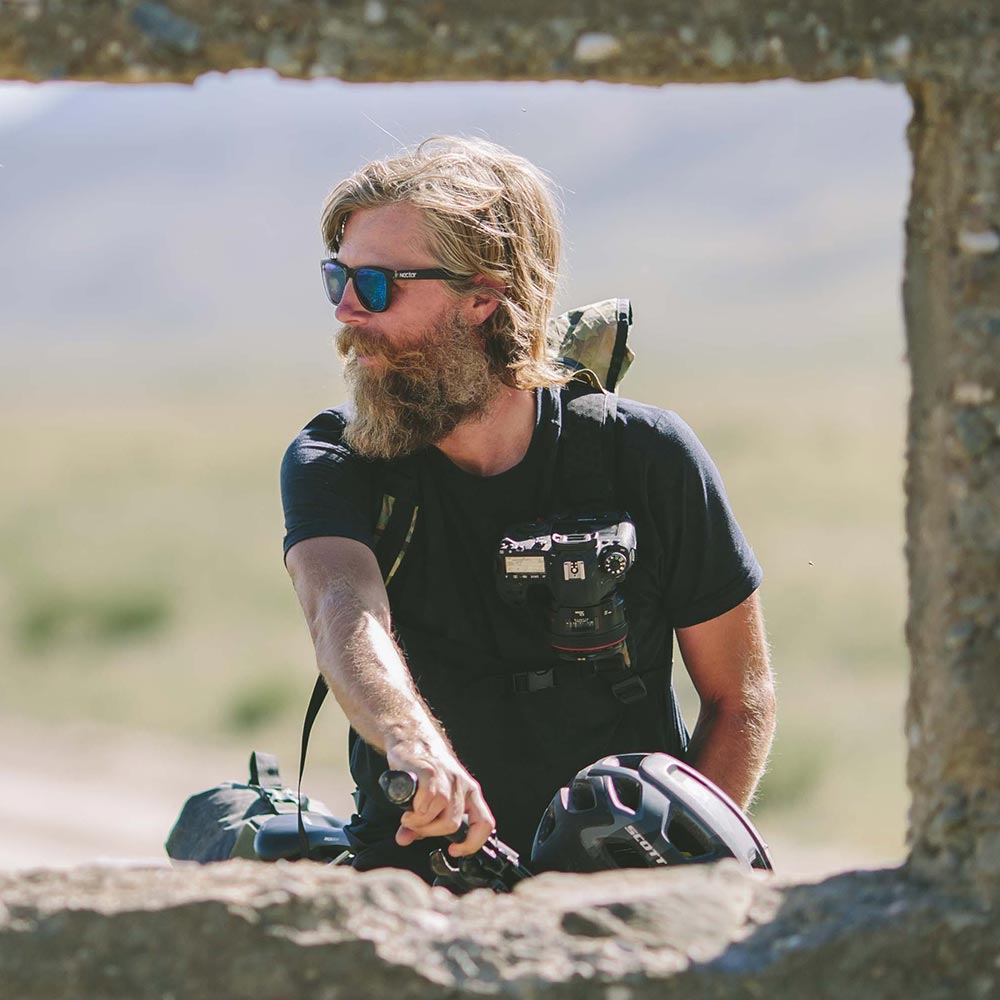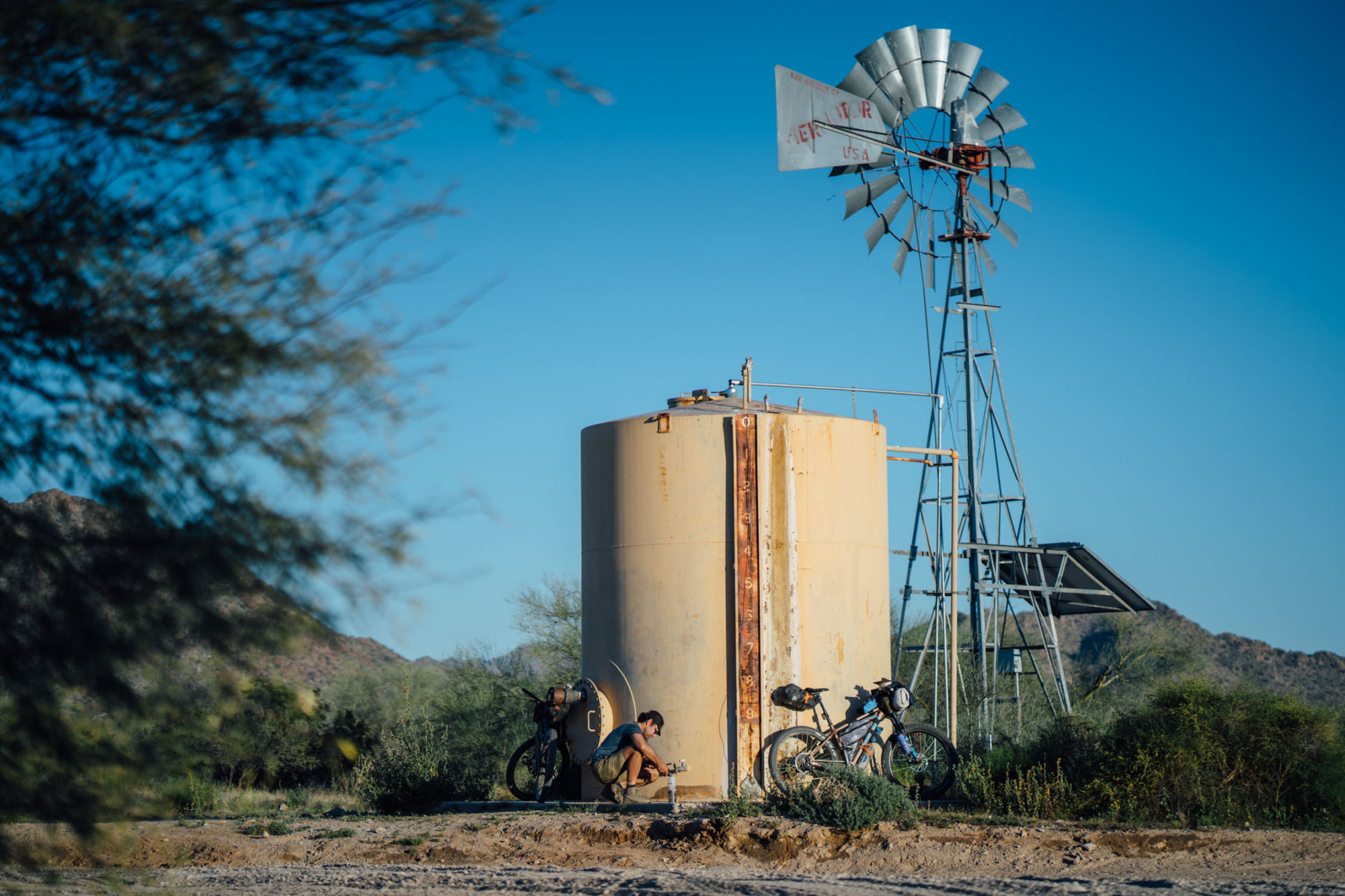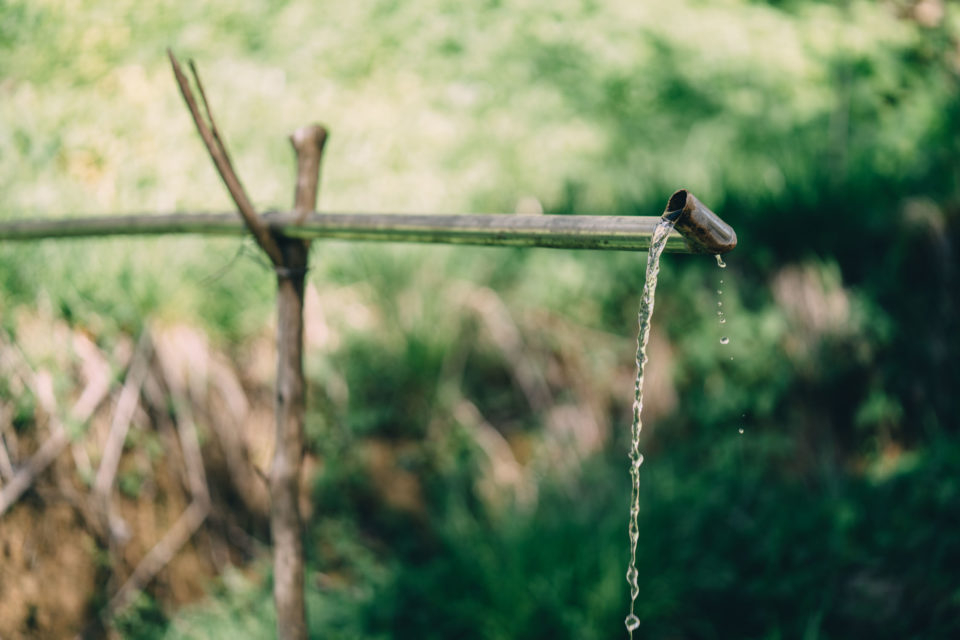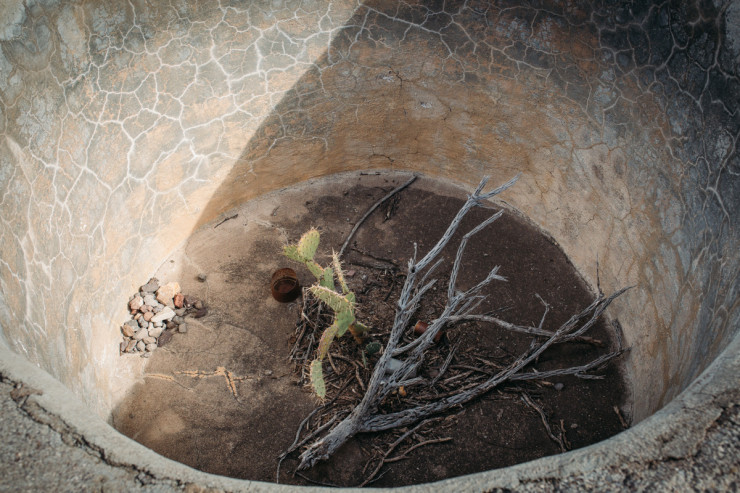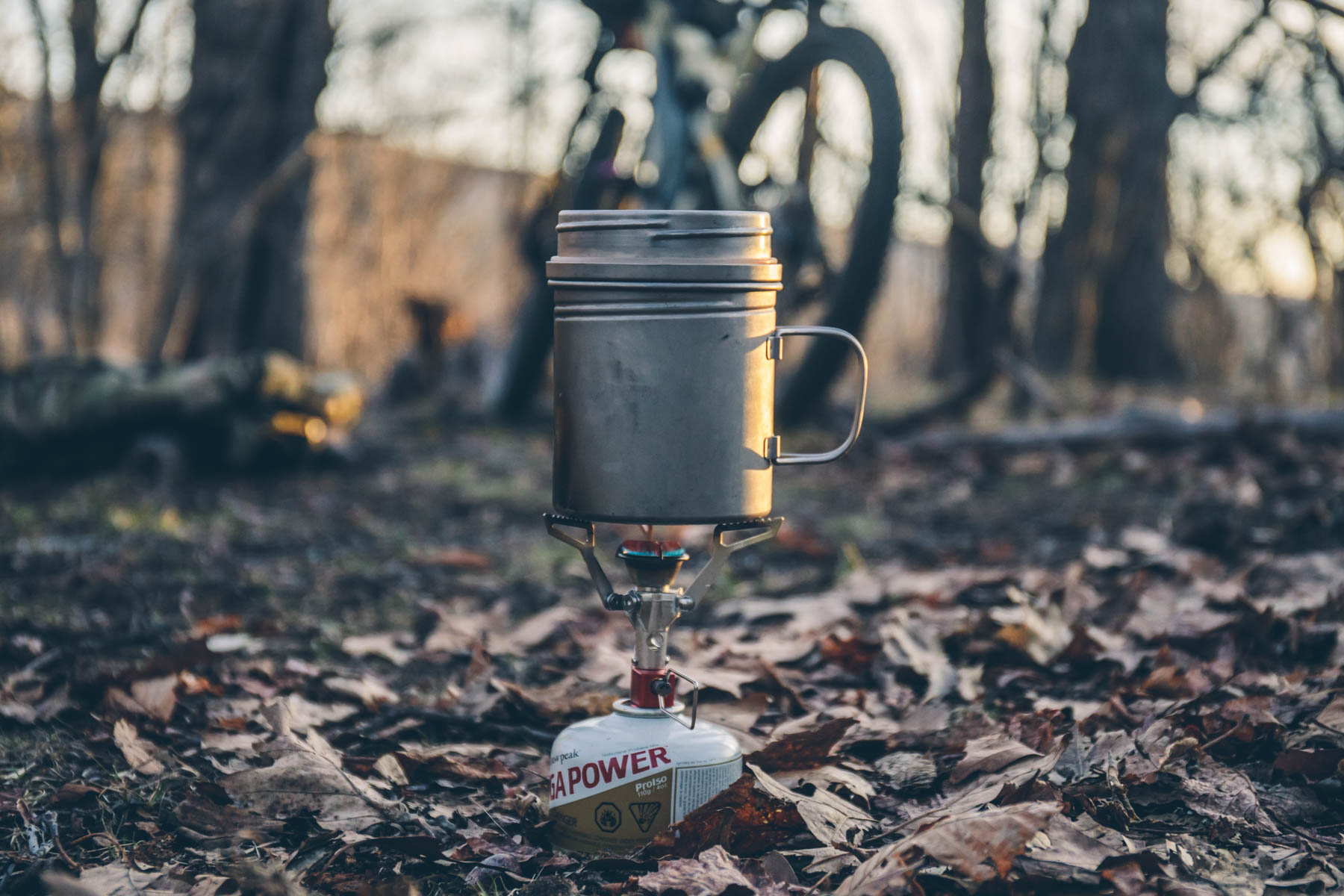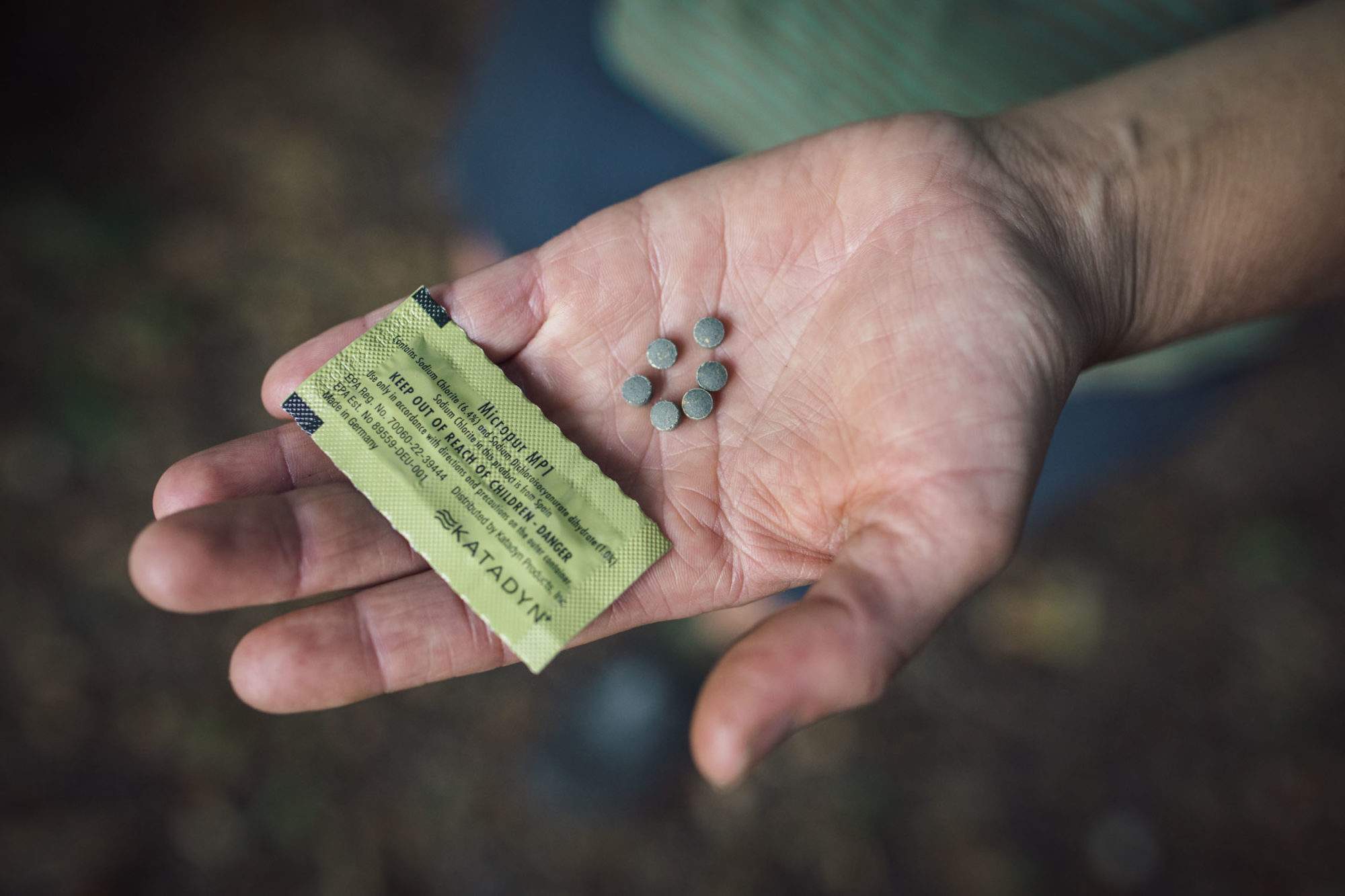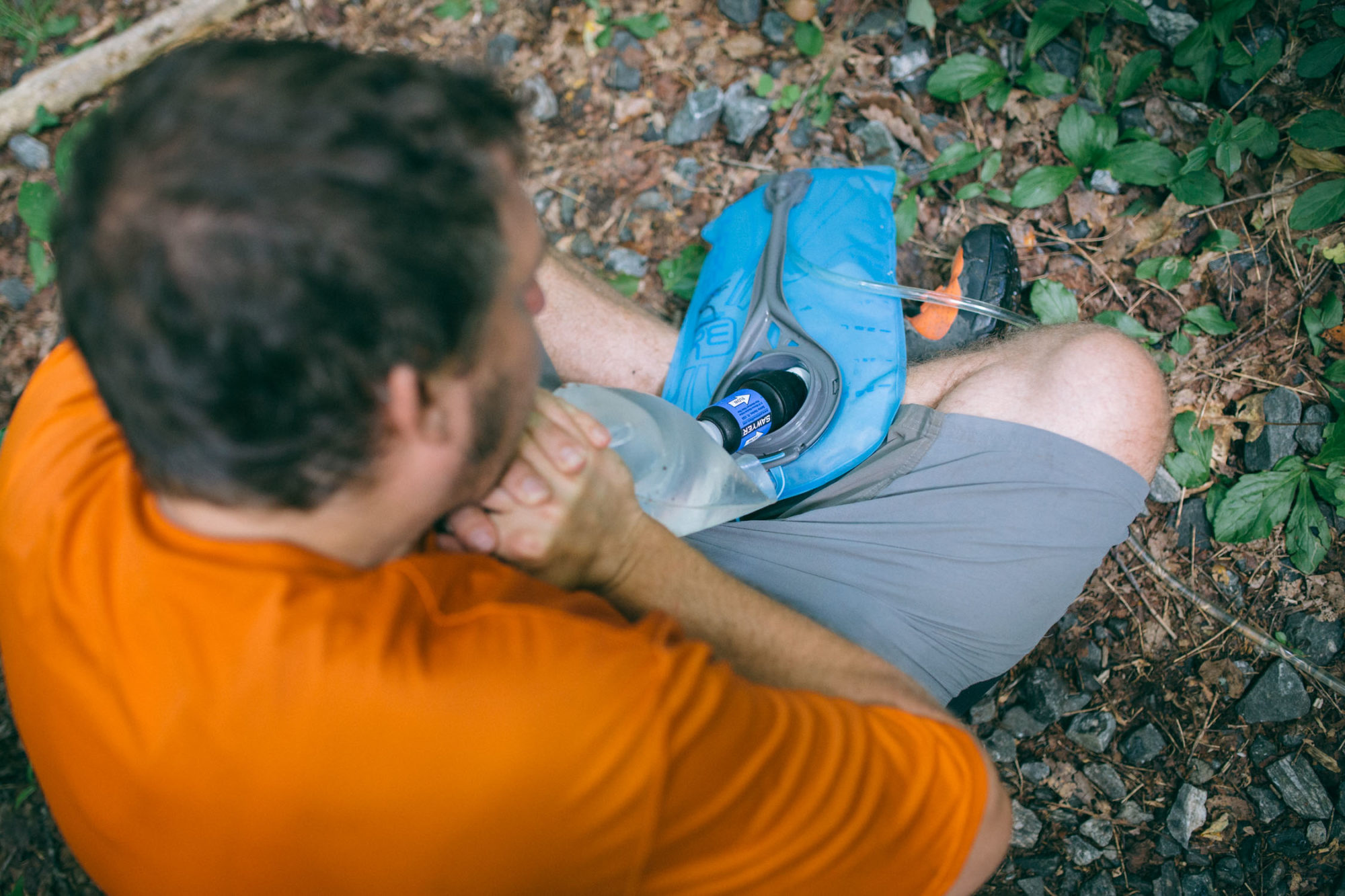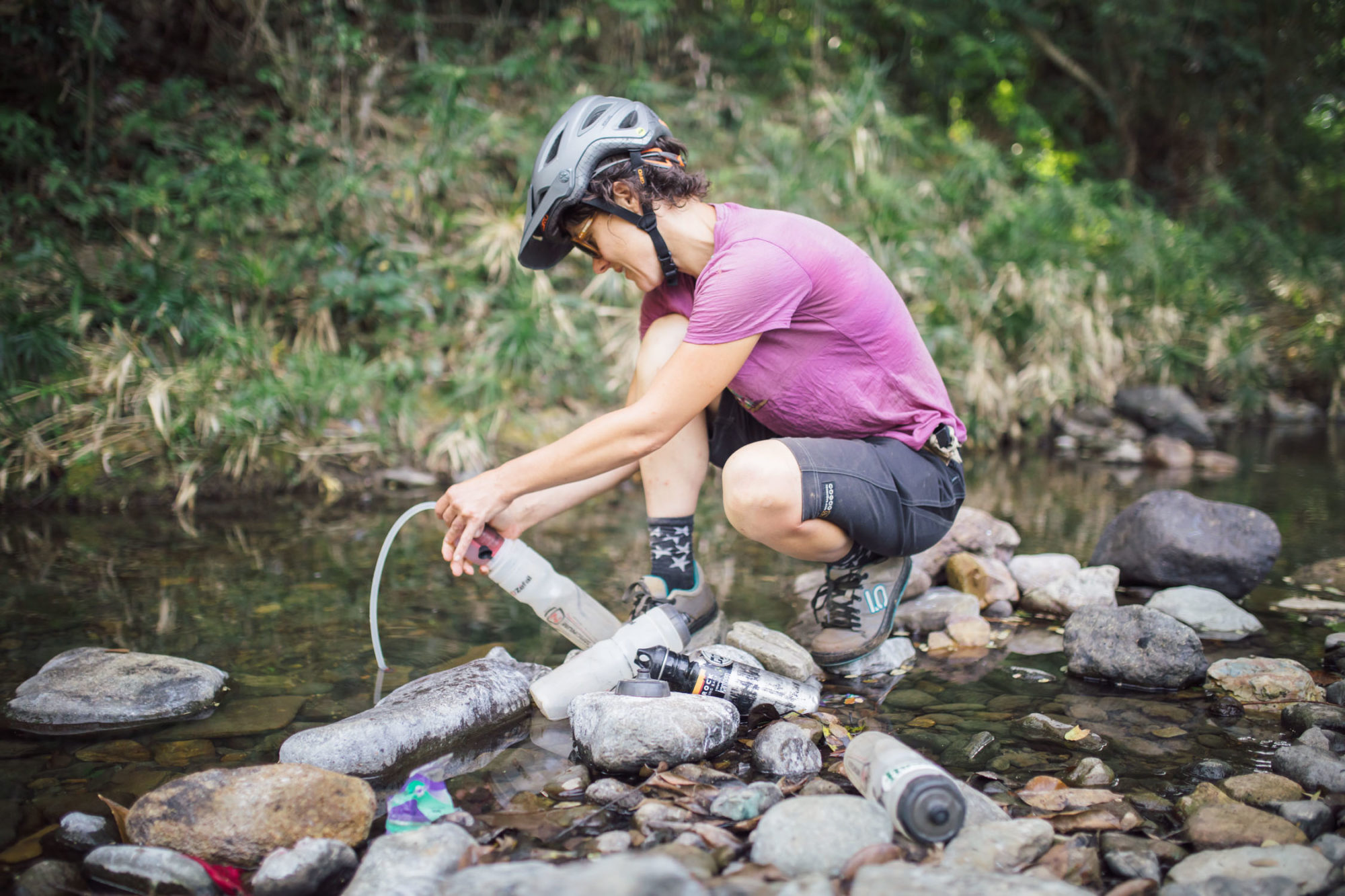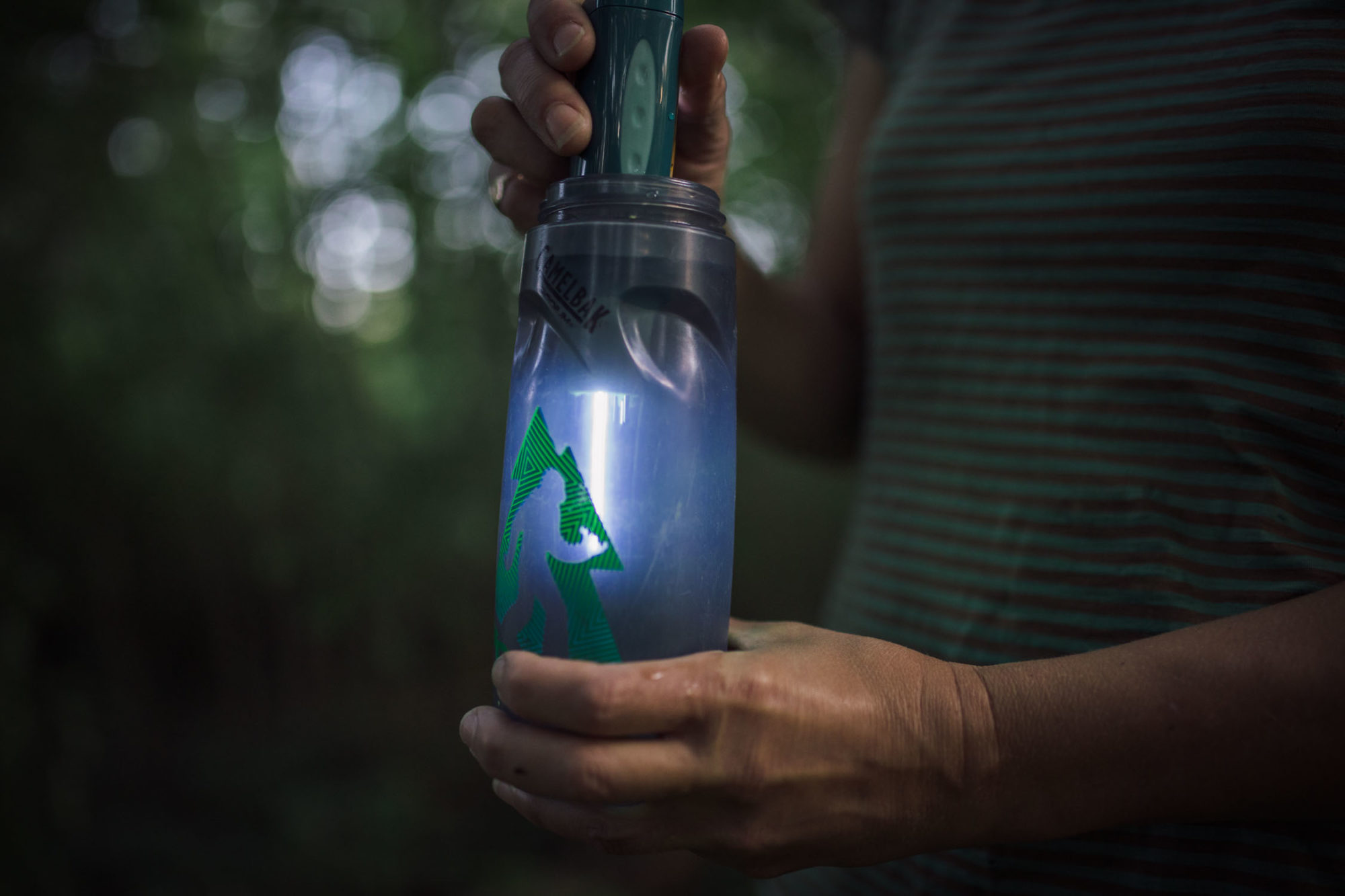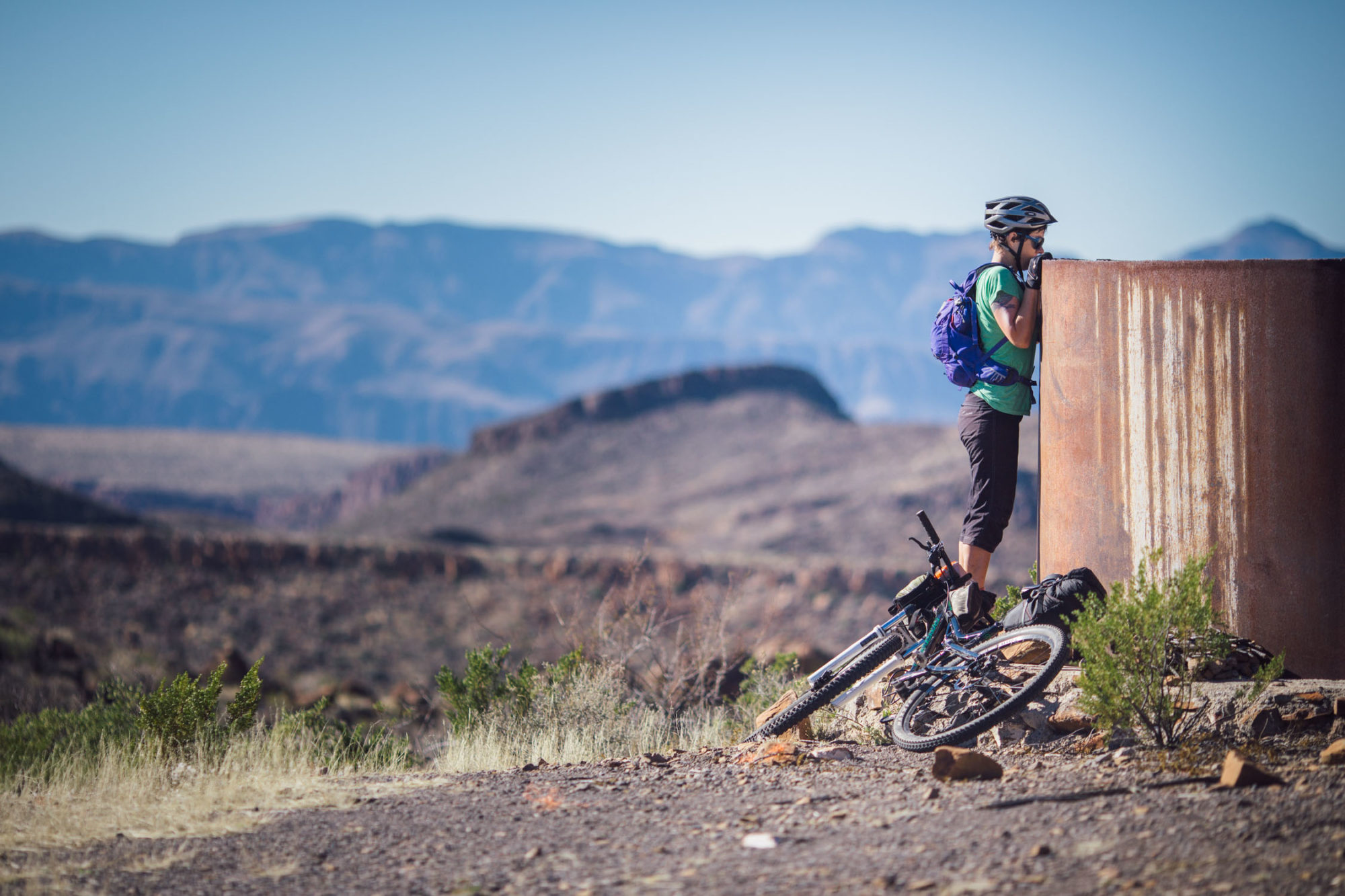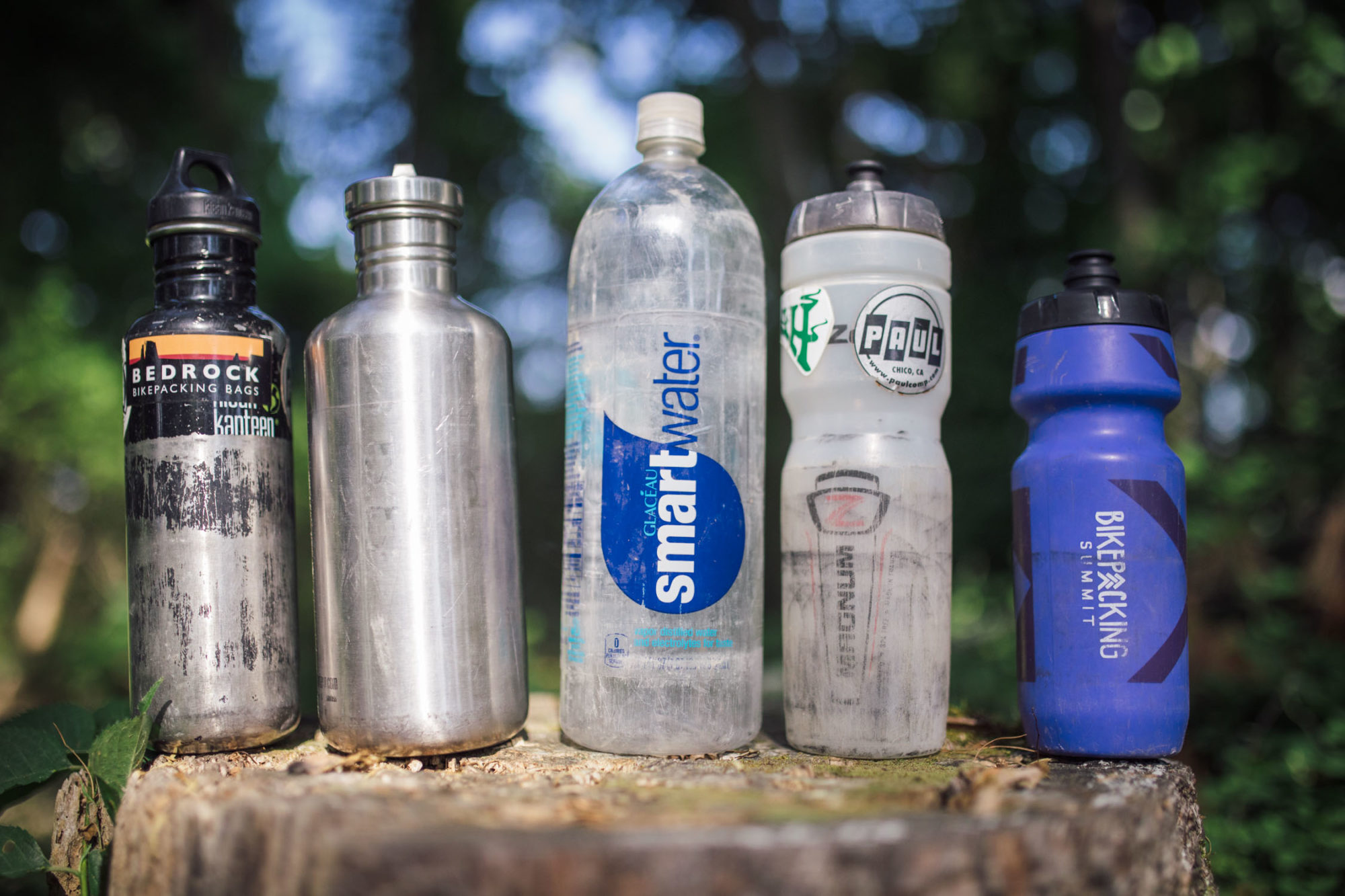[ad_1]
Share This
0
Thanks prematurely for spreading the phrase!
On this information, we take an in-depth have a look at ultralight water filters and purification strategies, evaluate a number of merchandise, determine the important components to think about when planning your bikepacking hydration and water remedy system, and reveal our editors’ decisions. Discover all of it right here…
Initially revealed in Might 2019; up to date July 2023
Sourcing and carrying water will be one of many trickiest components of planning your bikepacking equipment (and sometimes the journey itself). Whether or not it’s an overnighter or a month-long worldwide dirt-road tour, bikepackers nearly all the time require a number of water. Supplemental hydration is a essential requirement once you’re exerting the excessive stage of power required to pedal a loaded bicycle. And water is heavy, takes up useful actual property on the bike, and might typically be arduous to seek out. This information goals to assist simplify the method of staying hydrated whereas out on the bike.
We’ve got routes on this website the place water is plentiful, such because the Appalachian Gravel Growler, which is chock filled with clear springs and mountain streams. When bikepacking in one of these atmosphere, there’s no important purpose to hold greater than a liter bottle and a dependable filter. On the flip aspect, routes such because the Camino del Diablo in southern Arizona require a disproportionate quantity of water to be carried over a number of days. Then, there are routes via growing nations with faucet water supplied by questionable infrastructure, the place consuming water will be dangerous enterprise.
Some water flows from piped, crystal-clear springs that may be consumed as is. Different seemingly benign water sources are swimming with malevolent microorganisms. Moreover, many water sources could also be murky with deposits of white glacial silt, inexperienced algae, or sandy brown soil. Whereas bikepacking, you could face a number of of those eventualities, and the truth is there’s no superb, singular product or methodology for treating and purifying all consuming water. Each state of affairs is completely different.
On this information, we’ll cowl a number of standard, light-weight, moveable water remedy techniques and dig into mini-reviews, in addition to execs and cons of particular merchandise. We’ll additionally present just a few suggestions we’ve gathered alongside the best way, related hyperlinks to details about carrying further water, and shut with our editors’ most popular water remedy strategies. However first, let’s summarize the science behind water remedy and why it’s vital to think about a number of components when planning your equipment.
The Science of Pure Water
Whereas some individuals argue whether or not water filtration is important in some areas, most will agree that it’s apply to filter and/or deal with most naturally occurring water sources, in addition to many infrastructure-provided sources in growing nations. In response to the World Well being Group, water-related ailments are the main reason behind loss of life worldwide, and practically 25% of the worldwide inhabitants is consuming fecally contaminated water. Water can comprise micro organism, viruses, and parasites, together with protozoa and helminths (worms) that trigger quite a lot of ailments in people. Relying on the supply, it might additionally comprise quite a lot of toxins which might be doubtlessly hazardous to human well being. Except you’re completely certain in regards to the security of a water supply, there’s no purpose to threat your well being and smash a superbly good bikepacking journey. We’ve realized the arduous method, on a number of events, each within the backcountry and when touring overseas. Listed below are the issues that filters and varied water remedy techniques take away and/or deal with. Every has a single-letter abbreviation, which we’ll use to reference the capabilities of varied techniques later.
Protozoa (P)
Probably the most widespread water sicknesses one may encounter within the open air are brought on by protozoa. The 2 you’ve probably heard of are Giardia lamblia and Cryptosporidium (a number of species). Each of those parasites could go undetected of their hosts, however when signs do come up, the most typical criticism is diarrhea. Further signs could embrace abdomen cramping, fuel, nausea, vomiting, and fever. On the brilliant aspect, each of those nasty buggers are pretty giant—the Giardia cyst is roughly 7-10 micrometers (μm) in diameter, whereas the Cryptosporidium oocysts are normally 4-6 μm in diameter (1 micrometer = 0.001 mm = 0.00004 inches)—and are simply strained and eliminated by most out there filters. It’s vital to notice that Cryptosporidium is extremely immune to chlorine or iodine-based disinfectants. Chlorine dioxide, however, will deal with Cryptosporidium, however that remedy takes as much as 4 hours.
Micro organism (B)
There’s a variety of micro organism that may trigger issues if ingested. Escherichia coli, Campylobacter, Shigella, Salmonella, and Vibrio cholerae are just a few of the extra widespread bacterial pathogens present in water. An infection with these micro organism leads to a myriad of signs, together with diarrhea (presumably containing blood or mucus), nausea, vomiting, and cramping. Such beasties are considerably smaller than protozoa (between 0.2 to 1μm in width). Filtration is reasonably efficient at eradicating micro organism so long as one makes use of a filter with pores smaller than or equal to 0.3 micrometers in dimension, whereas disinfection with iodine or chlorine is extremely efficient at killing micro organism.
One other one we didn’t point out above is helminth infections, that are fairly nasty. If you happen to really feel so inclined (Virginia loves these things), perform a little analysis on Guinea Worm Illness. A few of these infections will be contracted through direct contact with the pores and skin, others via the chew of mosquitoes, and a few via the ingestion of contaminated meals or water. Fortunately, the only of filters are efficient at eradicating their eggs from consuming water.
Waterborne Viruses (V)
Viruses are a totally completely different ballgame. Water-transmitted viral pathogens acknowledged by the World Well being Group embrace hepatitis A and E, adenovirus, rotavirus, and norovirus, amongst others. Just like the beforehand mentioned pathogens, these viruses are mostly related to gastroenteritis, which might trigger diarrhea in addition to different signs, together with stomach cramping, vomiting, and fever.
It must be famous, although, that a few of these similar viruses may cause far more extreme sicknesses, together with meningitis, myocarditis, and hepatitis. Stopping waterborne sicknesses brought on by viruses requires a special method from these brought on by different pathogens. Viruses are significantly smaller than parasites or micro organism; they’re between 20-400 nanometres in dimension, about 100 occasions smaller than most micro organism. That is past the potential of most straightforward filters.
Ultrafiltration, nanofiltration, and reverse osmosis can take away particles of 0.01, 0.001, and 0.0001 µm, respectively, so they’re efficient in eradicating viruses. A number of the bigger, newer hole fiber filters match the invoice, however their price and comparatively sluggish output restrict their usefulness. Chemical disinfection and UV remedy are most likely a extra affordable possibility if publicity to viral pathogens will prolong past a few days. Each are efficient.
Chemical Contamination (C)
Though air pollution and contamination typically don’t instantly threaten your well being, there are microplastics, chlorine, mercury, arsenic, and natural chemical matter equivalent to pesticides and herbicides that most individuals don’t need of their system. Many filters declare to take away a few of these brokers, however these claims appear considerably nebulous.
Under, you’ll discover six classes of water filtration and purification and several other merchandise inside every of these classes. Farther down, discover suggestions for planning your hydration technique, beneficial water-carrying vessels, and our editors’ decisions.
First, Pre-filter
We’ve consumed water from sources starting from crystal clear springs to fully opaque, silty rivers to inexperienced livestock ponds, full with submerged cow patties. In lots of locations, equivalent to desert landscapes, water will be thick with grime. Algae, sediment, natural materials, and different particles give water an unappealing look. Bigger fragments can (and may) be eliminated by pouring water via a buff, bandana, espresso filter, or different semi-permeable membrane.
In truth, significantly soiled water can render a filter ineffective, and nearly all filtration system producers suggest pre-filtering all however the clearest water previous to utilizing their merchandise. This not solely will increase the effectiveness of the filter, it additionally extends its life. And, with UV remedy, filtration is required to permit mild to totally move via the water and “kill” undesirable pathogens. The perfect resolution we’ve discovered is a espresso filter, as buffs and different cloths typically aren’t efficient with high-quality silt. That mentioned, irrespective of the impermeability of the fabric you utilize, it’s no match for the microscopic world and doesn’t take away any contaminants, aside from helminths, that will trigger well being points.
Cleansing Water With Alum
One other trick for “cleansing” soiled water is utilizing Aluminum Sulfate, also called alum. Alum is offered in powder type and will be present in most grocery shops (examine the seasonings and spices aisle). It’s usually used for pickling, dying garments, and tanning leather-based. Nonetheless, it’s additionally a coagulant, and when combined with silty water, it bonds with grime particles, inflicting them to sink to the underside. This leaves comparatively clear water on the prime of the vessel.
Right here’s the way it’s carried out—word that these measurements are approximate. First, add about 5ml (1 teaspoon) of alum to 5 ounces of unpolluted (ideally heat) water. Stir in and permit it to dissolve. You may then add a few of the focus to soiled, brown water—about one ounce (30ml) of focus per one liter of soiled water. Then wait about half-hour to an hour. The alum powder will bind to the sediment, inflicting it to sink to the underside. The clear water on the prime can then be poured into one other vessel and filtered or handled with a UV mild. Be aware that though alum is accepted as a meals additive by the US Meals and Drug Administration, it could be poisonous in giant doses.
Boiling Water (P,B,V)
Boiling water is probably the most tried and true methodology for killing waterborne pathogens. Nonetheless, it’s time-consuming and requires a hearth or using treasured cooking gas, so it’s not probably the most environment friendly. So far as how lengthy to boil water, it relies on who you ask. The US Middle for Illness Management states, “Boiling can be utilized as a pathogen discount methodology that ought to kill all pathogens. Water must be delivered to a rolling boil for one minute. At altitudes better than 6,562 ft (better than 2000 meters), you need to boil water for 3 minutes.”
Professionals
- Kills all waterborne pathogens
- Doesn’t require further filters or pre-filter provides
Cons
- Time consuming and inconvenient mid-ride
- Campfires should not sustainable and/or harmful in lots of areas and don’t observe LNT pointers
- Requires further gas if utilizing a range
Chemical remedy (P*,B,V)
Chemical drops and tablets are additionally fairly efficient towards most waterborne critters. Nonetheless, not all chemical remedies are equally efficient towards all microbes. The time it takes to deal with completely different pathogens varies. A few of these remedies additionally depart a cool style. Listed below are the professionals and cons adopted by three options that we’ve used and like.
Professionals
- The lightest weight of all of the choices listed right here
- Can purify soiled water and doesn’t essentially require further pre-filter provides; hazy water does comprise substances that may neutralize disinfectant, so remedy would require larger doses or longer contact time
- Takes hardly any work to make use of; simply wait time
Cons
- Not instant; you have to wait some time earlier than consuming
- Most don’t work on Cryptosporidium cysts
- Don’t take away contaminants, equivalent to microplastics or metals
- Some have disagreeable style
- Iodine can have well being penalties for sure populations**
-
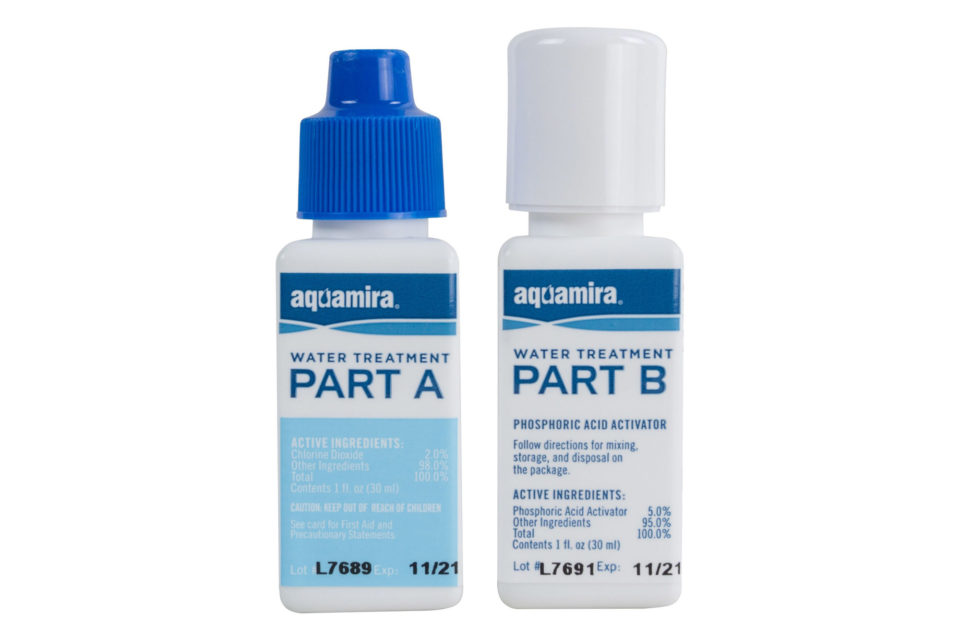
Aquamira (P,B,V)
Aquamira is without doubt one of the hottest chemical remedies available on the market and makes use of Chlorine Dioxide to deal with water—the identical chemical utilized by municipal water remedy vegetation to kill quite a lot of waterborne pathogens for the reason that late Forties. It kills micro organism and doesn’t have an effect on the style of water as a lot as iodine. Aqua Mira is available in a small, light-weight, half A/half B equipment (two 1oz plastic bottles) that has the potential to deal with as much as 30 gallons of water within the subject. Nonetheless, earlier than consuming the handled water, a major wait time is required. Aqua Mira suggests ready quarter-hour to kill Giardia, micro organism and viruses. An extra 3 hours and 45 minutes are required to kill Cryptosporidium.
26 grams / Treats ~113 liters / $14.95 at REI
-
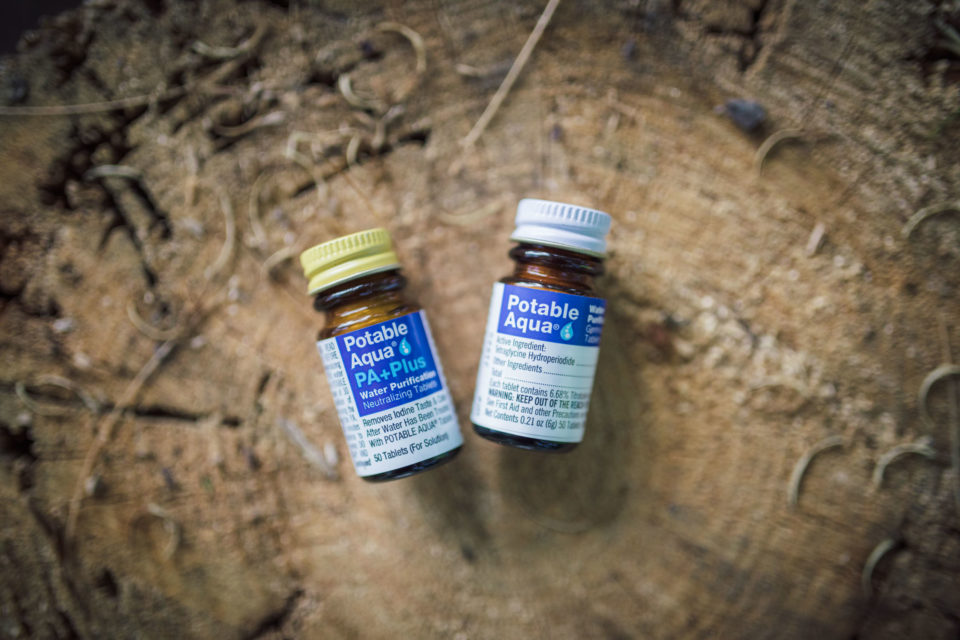
Potable Aqua—Iodine (P*,B,V)
For a lot of of us, the style that iodine imparts on water makes it a no-go, however I’ve been utilizing the tablets for years whereas backpacking and bikepacking. Potable Aqua makes a two-part model that has a reasonably efficient style neutralizer, though dried lemon or a hydration pill appear to work somewhat higher. *Iodine makes most water appropriate for consuming, though it’s not efficient towards Cryptosporidium. Every bottle consists of 50 tablets; two iodine tablets deal with roughly one liter of water. Potable Aqua tablets require that you simply wait not less than half-hour earlier than consuming the handled water. **Necessary: Water that has been disinfected with iodine is NOT beneficial for pregnant ladies, individuals with thyroid issues, these with recognized hypersensitivity to iodine, or steady use for quite a lot of weeks at a time.
15-100 grams / Treats ~25 liters / $11.95 at REI
-
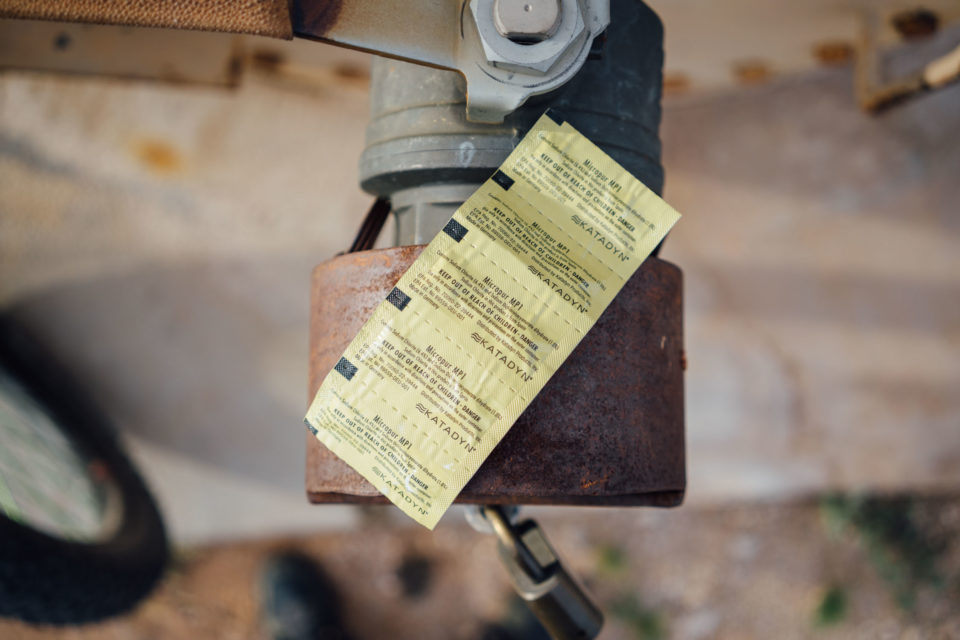
Katadyn Micropur Tablets (P,B,V)
I used these tablets for the primary time over the winter in Arizona. General, I’m fairly impressed. They’re tiny, weigh nothing, and don’t impart a powerful style, only a slight chlorine/disinfectant taste. Like Aquamira, Katadyn Micropur tablets are based mostly on the chemical remedy utilized in most municipal water provides and are efficient towards viruses, micro organism, Giardia, and Cryptosporidium. The wait time varies relying on what microbes you’re battling—viruses and micro organism are killed in quarter-hour, Giardia in half-hour, and Cryptosporidium in 4 hours. Every pill is individually wrapped and sealed in minimal packaging (though it’s plastic), and purifies about one liter of water.
~15 grams / Treats ~30 liters / $13.95 at REI Backcountry
Squeeze/Bag Filters (P,B,C)
Squeeze/bladder bag filters are the rising stars on the planet of light-weight and compact backcountry water remedy gadgets. Merely put, they’re straightforward to make use of, pretty efficient, small, and light-weight. That mentioned, filters clog, and whereas most will be backflushed to clear particulates, they typically don’t final so long as firms may declare. We’ve examined a number of fashions and efficiency/pace varies.
Professionals
- Very light-weight and collapsible
- Squeeze luggage can be used for auxiliary water storage
- Pretty quick, and water is straight away drinkable
- Most take away some contaminants (plastics, metals, and so on.)
Cons
- Can develop into clogged and very sluggish; lifespan is normally lower than what firms declare if you happen to filter something aside from completely clear water
- Don’t kill viruses
- Freezing temperatures smash these filters. In case of freezing climate, preserve the filter in a pocket, sleeping bag, or in any other case near your particular person.
-
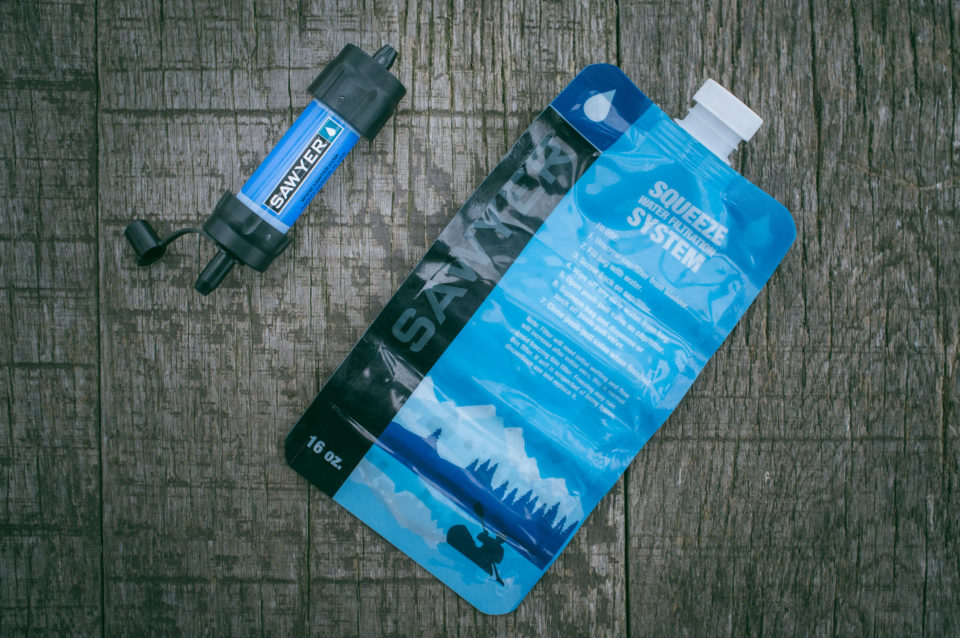
Sawyer Squeeze
Sawyer Squeeze has been round for some time and has been my go-to water filter for years. The luggage will be iffy—I’ve had just a few break and spring leaks—so carry a pair (I choose the bigger 64oz model). The filter itself is dependable, light-weight, compact, and cheap. It’s not resistant to clogging, nonetheless. Ensure water filtered via it’s pretty clear. Additionally, on longer journeys, it’s useful to carry alongside the included syringe to backflush it occasionally. Sadly, like different hollow-filament-based filters, it might’t be stored in sub-freezing temps as soon as it has had water in it; freezing water contained in the hole fibers can destroy the membrane. The Sawyer Squeeze techniques use a 28mm threaded prime, to allow them to even be screwed onto a regular disposable bottle. Whereas you may get the mini for just a few {dollars} much less, we just like the common model because it appears to take care of a greater movement for longer.
~85 grams / Treats as much as 100,000 gallons / $41 at REI
-
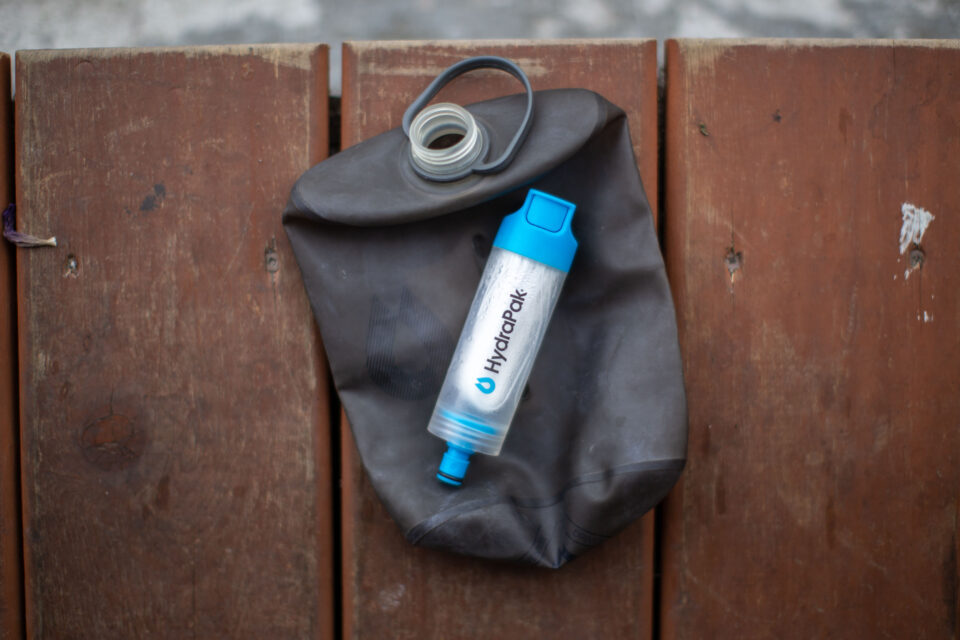
Hydrapak 28mm and 48mm Filters
The Hydrapak 28mm and 48mm Filers are thread-on fashion squeeze filters designed to work seamlessly with their different hydration merchandise, together with flasks, reservoirs, and reservoir traces, and every filter successfully removes widespread waterborne micro organism and protozoa from roughly 1,500 liters of water at a price of >1L per minute. The 42mm Filter Cap ($35) is suitable with all HydraPak 42mm opening merchandise, together with working flasks, Seekers, and Flux bottles. The 28mm filter equipment ($40) threads immediately onto bottles and flasks or connects to Plug-N-Play techniques used on reservoirs and water storage containers. Learn the total evaluate right here.
47-57 grams / Treats as much as 1,500 liters / $35-$40 at REI
-
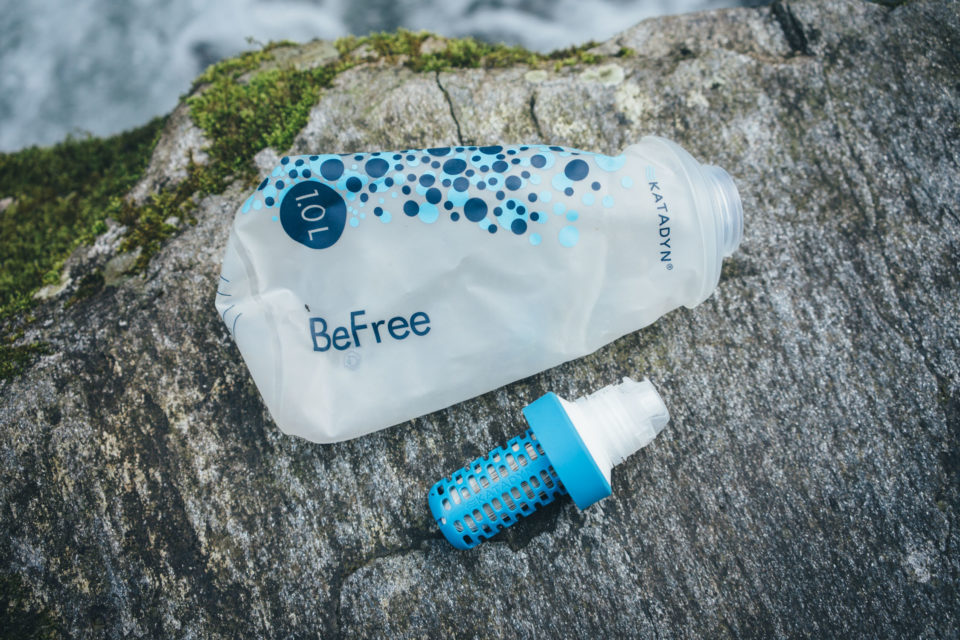
Katadyn BeFree (1.0L)
I used to be launched to the Katadyn BeFree on the CDT in 2018 and actually favored it. It has a one-liter delicate rubberized bottle with a 42mm threaded prime that absolutely collapses and a screw-in filter with a spout. You merely fill the bottle, screw within the filter, flip it the wrong way up, and squeeze. When it’s new or clear, water flows via the filter at a extremely good price, sooner than the Sawyer. Katadyn claims it filters as much as two liters of water per minute. To wash, you shake or swish the filter in clear water to take away particles. All that mentioned, that was another person’s that labored very well on that journey, however I had an issue with a brand new one because it clogged fairly quick within the subject.
UPDATE: I’ve now used this filter over a number of seasons, and it’s develop into my favourite for day rides, overnighters, and week-long bikepacking journeys, alike. It’s quick, dependable, and so long as you swish it in clear water after just a few makes use of, it retains working extraordinarily nicely.
62 grams / Treats as much as 1,000 liters / ~$40 at REI Backcountry
-
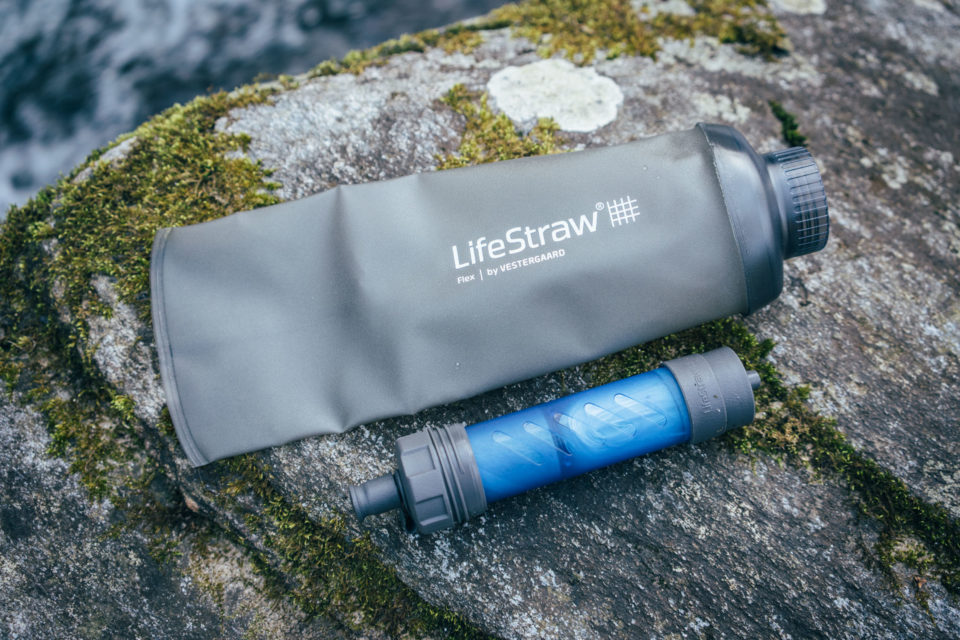
LifeStraw Flex (now Peak Squeeze)
Just like the Sawyer, the LifeStraw Flex Twin Filter system can be utilized in quite a lot of methods: by itself as a easy straw filter, as an inline filtration system, as a gravity filter, or with the included 650ml rubberized bag as a squeeze filter. What makes the Lifestraw Flex particular is its two-stage filter. Just like the others listed right here, it has a hollow-fiber membrane that filters to 0.2 microns. It additionally has an activated carbon filter that reduces natural chemical matter equivalent to pesticides, herbicides, heavy metals, and VOCs. Each of those filters are simply replaceable. The membrane filter has a lifespan of about 500 gallons, and the carbon filter is nice for about 25. One other factor that makes the lifeStraw Flex fascinating is the interface. The filter has two threaded sides, one which’s threaded externally for the bag (or it can be used with the 28mm CNOC Vecto 2L) and one other aspect that has inside threading to mate with a regular plastic water bottle. All that mentioned, my large criticism with the Lifestraw Flex is that it’s actually sluggish, the slowest of the three listed right here. I additionally want the included bottle bag was nearer to 1L.
110 grams / Treats as much as 500 liters (25 with carbon) / $34.95 at REI
Pump Filters (P,B,C,V*)
Typically talking, pump filters have been round lots longer than most. Nonetheless, they’re cumbersome, heavy, and not likely superb for bikepacking. Nonetheless, they work nicely and are typically sooner and maybe a bit extra dependable than squeeze filters.
Professionals
- Pretty quick, and water is straight away drinkable
- Most take away some contaminants (plastics, metals, and so on.)
Cons
- Can develop into clogged and sluggish
- Many don’t kill viruses
- Large, typically heavy, and never as bikepacking-friendly as different options
-
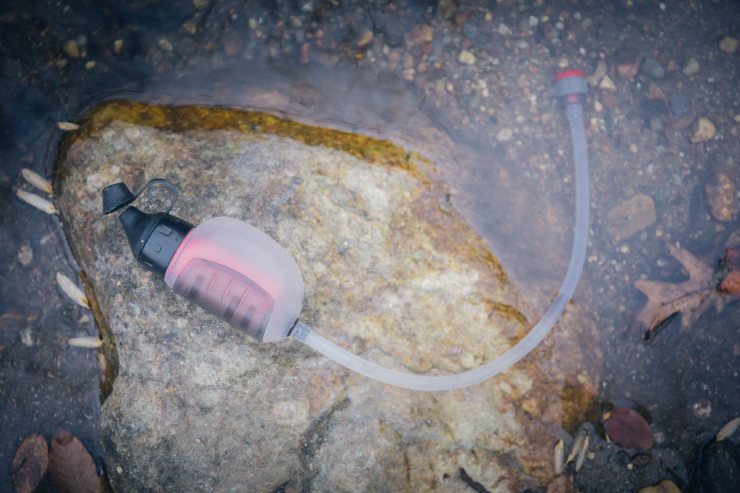
MSR TrailShot
The MSR Trailshot is hardly a pump filter within the conventional sense of the class. Nonetheless, it doesn’t actually match into any of the opposite classes. It additionally doesn’t match with the professionals and cons above. Given its dimension (smaller than a beer can), weight (153g), worth ($50), and pace (1L per minute), the TrailShot looks as if the right system for jaunts the place there are many water sources to dip into. Upon first use, it was clear that this product is a winner for such exploits. Nonetheless, on our Trans-Cuba experience/route, the place the hydration necessities have been excessive and the water sources variable, the TrailShot’s movement price was regularly decreased to a trickle, albeit partially as a result of ignorance on our half. We didn’t get sick on that journey, however care should be taken to maintain the TrailShot flowing nicely. MSR claims the filter cartridge lasts as much as 2,000 liters, however I’m fairly certain ours didn’t come shut earlier than needing a substitute. Learn the total evaluate right here.
153 grams / Treats as much as 2,000 liters / $49.95 at REI Backcountry
-
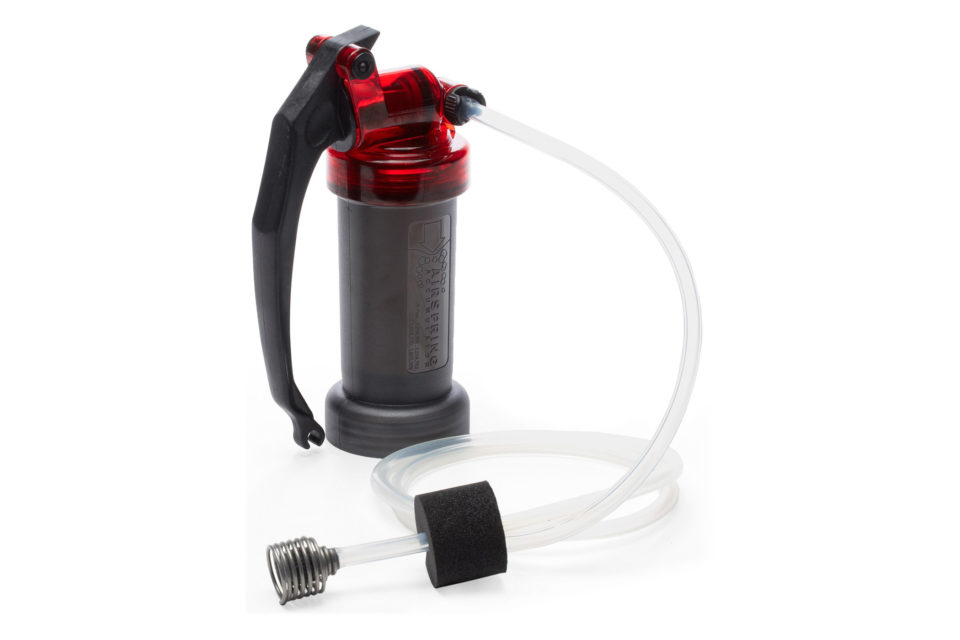
MSR MiniWorks EX Water Filter
Whereas we haven’t used the MiniWorks EX, we’ve heard it’s the most effective true pump filters available on the market. It contains a ceramic/carbon factor that successfully removes micro organism and protozoa together with Cryptosporidia. It additionally removes natural compounds equivalent to metals and pesticides. Nonetheless, it weighs a whopping 415 grams (14.6 oz) and is pretty giant.
415 grams / Cartridge life: ~2000 liters / $89.95 at REI Backcountry
UV Remedy/Pens (P,B,V)
Ultraviolet mild is a kind of electromagnetic radiation—the identical stuff answerable for sunburns. And whereas it could have many antagonistic results, it might additionally make water protected to drink. UV pens (SteriPens) use a shortwave germicidal UV mild supply that disrupts the DNA or RNA in viruses or micro organism, thus destroying their means to breed and successfully making them innocent to the human physique. In clear water, the SteriPEN will destroy over 99.9999% of micro organism, 99.99% of viruses and 99.9% of protozoa. Nonetheless, the water during which it’s used must be freed from particulates that bugs might doubtlessly “disguise” behind.
Professionals
- Light-weight and small
- Pretty fast (about 90 seconds)
- Kills all micro organism and protozoa and is efficient towards viruses
Cons
- Requires batteries or re-charging
- Generally fail within the subject
- Water should be clear, so important pre-filtering could also be required
- Doesn’t take away contaminants, equivalent to microplastics or metals
-
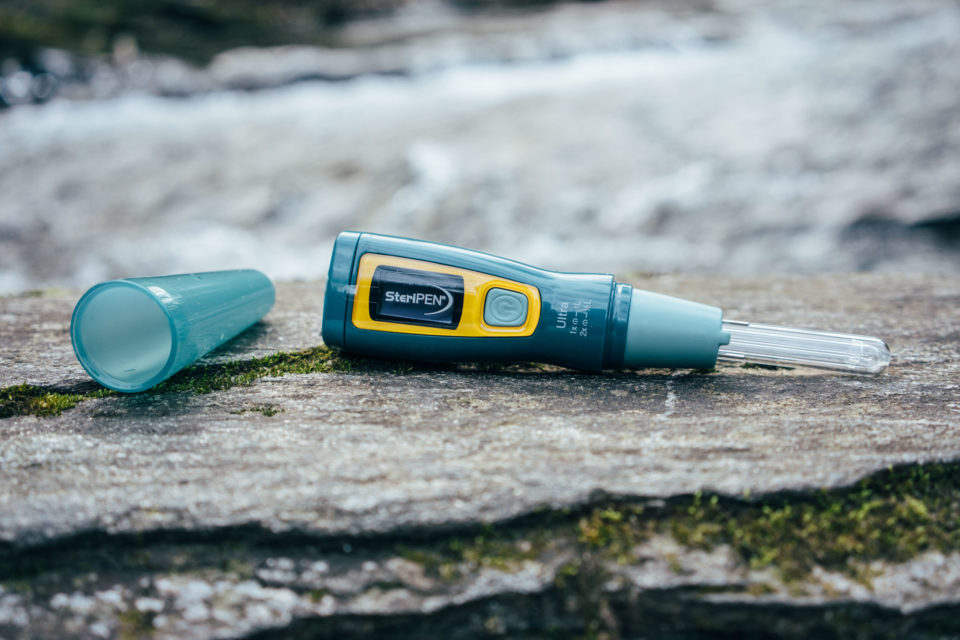
Steripen Extremely
The Steripen is available in quite a lot of configurations, however the Extremely is the one one which’s rechargeable through USB. Steripen Extremely options an inside battery that may be recharged from any USB energy supply, together with a photo voltaic panel, Dynamo Hub, or cache battery. Sadly, the Extremely is the biggest and heaviest of Steripen’s choices, and Steripen did away with their Freedom model, which was a a lot smaller rechargeable unit. The Extremely additionally contains a low-power indicator to let you recognize when the battery wants recharging. When absolutely charged, you’ll be able to deal with 50L of water.
135 grams / Treats as much as 50 liters/cost / $109 at REI
Gravity and Inline Filters (P,B,C)
Gravity filters work in an analogous method to squeeze filters and sometimes use the identical inline filter, however they let gravity do the work as a substitute of your palms. Some perform higher than others, however they’re typically easy to function, though they take a while. Velocity varies between fashions, and their normal execs and cons are just like squeeze filters. That mentioned, the baggage that include gravity filters are sometimes overbuilt and heavier than easy squeeze bladders.
-
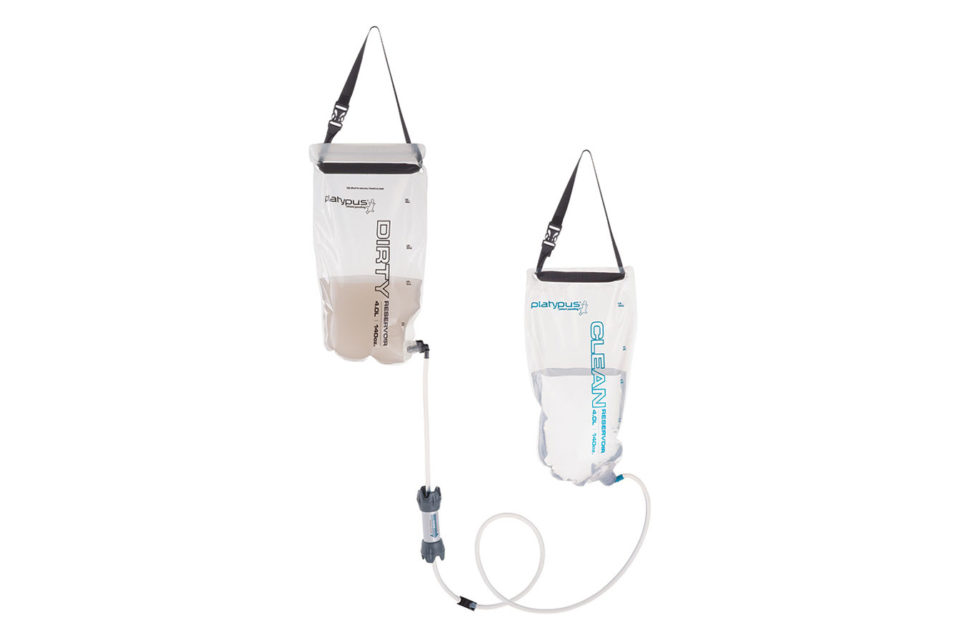
Platypus GravityWorks filter
Whereas I haven’t used the Platypus Gravityworks system, I’ve heard good issues about it for group tenting or household bikepacking. The system features a 4-liter soiled water reservoir, 4-liter clear water reservoir, hollow-fiber microfilter, hoses, shutoff clamp, and storage sack. The replaceable cartridge filters as much as 1,500 gallons, and the equipment weighs 11.5 ounces. It’s additionally made within the USA. Cass places it to work whereas pitching the household tent or having lunch. Platypus claims 1.75 liters per minute.
305 grams / Treats as much as 1.75 liters / ~$80 at Backcountry
-
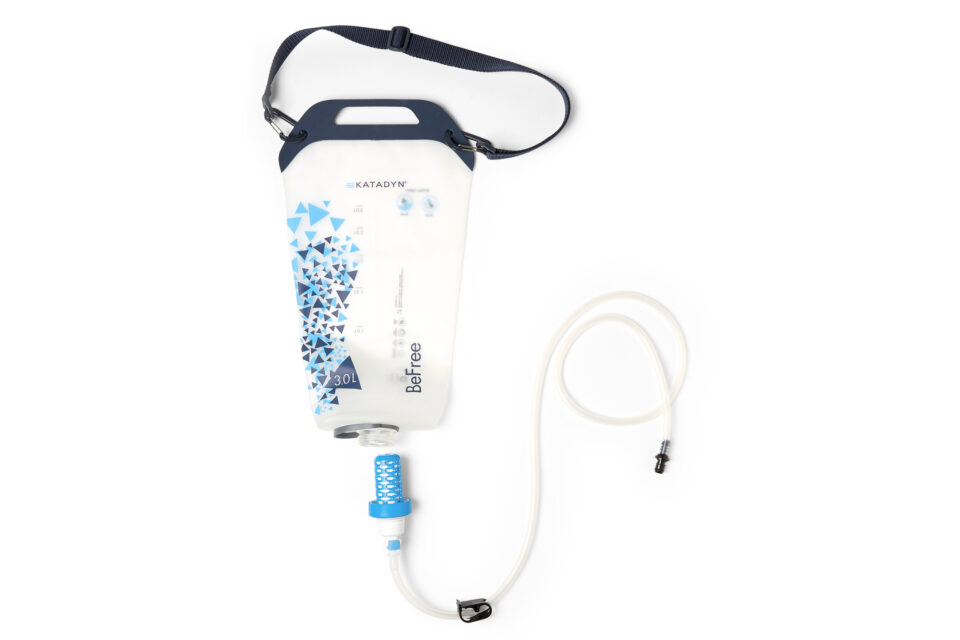
Katadyn Gravity BeFree Water Filtration System
The Katadyn Gravity BeFree 3-liter single bladder system is somewhat easier. It comes with a 3-liter reservoir bag and the identical threaded water filter used on the 1-liter BeFree. In comparison with the usual BeFree filter, this consists of an output hose that allows you to fill water bottles and hydration techniques whereas hanging. The output hose has quick-connect, hydration-pack adapters, too. We haven’t tried this, nevertheless it seems to be promising. Katadyn claims it filters as much as two liters per minute.
193 grams / Treats as much as 1,000 liters / ~$60 at REI
Bikepacking Ideas for Hydration/Remedy
1. Know your sources
Pay shut consideration to potential water sources and the way a lot it’s good to keep on day-to-day rides. For filtration/sterilization, have a look at the way you’ll be sourcing water. When touring in growing nations, for instance, consuming water from spigots and taps requires some type of remedy. In these conditions, it’s far simpler and fewer time-consuming to make use of a chargeable Steripen as a substitute of a filter.
2. Mark sources on the map
Earlier than your journey, examine the map to seek out locations the place you’re prone to discover rivers and streams. Equally, map out cities that will have public fountains, comfort shops, or eating places the place you’ll be able to replenish. In our expertise, church buildings, colleges, police and fireplace stations, and different such institutions are additionally good choices.
3. Carry a foldable bladder
Carry alongside an extra 2-3 liter water bladder for when further water is required, equivalent to at a dry campsite. Bladders fold up simply or lay flat in your framebag. We actually just like the Platypus Platy 2L because it additionally mates with the Sawyer Squeeze filter to supply a backup filtration bag. Another choice is the Cnoc Vecto 2L bag which has a full-width zip opening and is available in two completely different sized/thread patterns, the 28mm possibility that mates with the LifeStraw flex, and the 42mm threaded possibility for the Katadyn BeFree.
4. Carry backup chemical compounds
If you happen to resolve to make use of a filter or Steripen as your essential device for water remedy, carry backup purification tablets or drops. Tablets typically weigh nothing. And in case your filter fails, you’ll have the ability to sterilize water in a pinch.
5. Use a BOT
I’ve been utilizing the Vargo BOT for six years now. It’s an awesome prepare dinner pot that doubles as a sealed water bottle. This is available in significantly useful for carrying further water when essential. It’s additionally useful as a vessel for UV remedy.
6. Know your bugs
Ensure to seek out out what you’re up towards within the nations the place you’ll be touring. Once we’ve traveled via East African nations, it’s been in our greatest curiosity to carry a filter in addition to a Steripen to double the efficacy towards viruses and micro organism.
7. Use your cooking pot or dangle-mug
Skimming floor water from a pond, river, or slow-moving stream is all the time a problem with a water bladder. Use your camp mug or cooking pot to dish water out into your bag. It’s an apparent resolution, however one purpose a “dangle mug” can come in useful.
8. Resist Plastic
It doesn’t matter what, we all the time try to carry the mandatory filtration and purification techniques to keep away from shopping for disposable plastic bottles. This normally means a UV SteriPen for faucet water in growing nations.
9. Carry soiled water to camp
As apparent because it might sound, that is one trick that helps save time. That’s, throughout your final water replenish for the day, don’t filter. As a substitute, simply fill your soiled bottle or bladders with water and produce them to camp. In case your meal requires boiling water, that may purify it anyway.
4 favourite water bottles
Everybody has their very own favourite strategies of carrying water. Bladders and bottles are the most typical. You may dig into our bottle cage Gear Index to seek out options for carrying bottles, each commonplace and outsized. Additionally, take a look at Methods to Connect Bottle Cages for a listing of options for securing bottles in atypical locations or if you happen to don’t have bottle mounts in your body. So far as bottles go, listed below are 4 bottles that we’ve used and suggest for varied conditions:
Klean Kanteen single-wall (27oz and 40oz)
Traditional stainless Klean Kanteen bottles are available 27, 40, and 64oz sizes and are good for prolonged bikepacking journeys. Not solely are they invincible, they can be positioned in a hearth or on a range and used to soften snow and heat/boil water. Plus, chrome steel is the cleanest of supplies for storing liquids and doesn’t leach plastics or dangerous chemical compounds. Test costs on Amazon.
Zefal Magnum 1L
Whereas it seems to be like a standard water bottle and matches in a regular cage, Zefal’s Magnum holds a full liter (33oz). They’re additionally fairly powerful. I’ve been utilizing the identical set of Zefals (apart from one I misplaced) for about 5 years. Test worth on Amazon.
Specialised Purist
Specialised Purist bottles are made in California, BPA free, and have a number of spout choices, together with the aptly named “Watergate.” Purist know-how shields the within of the bottle from mould and marking, which is nice on lengthy journeys.
Recycled SmartWater 1.5L bottles
There are a number of outsized bottle cages that bikepackers use when touring via water-starved locales. The Topeak Modula XL and the CINQ Expedition cage come to thoughts. “Single-use” PET plastic bottles are actually the one bottles match for these odd, outsized cages. One such bottle that appears to work nicely is the SmartWater 1.5L bottle. This one’s been in use for some time…
Wrap Up (Editors’ Alternative)
As referenced in all of the descriptions above, Virginia and I’ve tried many of those options through the years, and a few that aren’t listed right here. Typically I swap up based mostly on my location/state of affairs, however on longer journeys with variable sources, I feel the perfect one-two punch is to hold a Steripen Extremely and a Sawyer Squeeze Mini—together with the included cleansing syringe, a 64oz Sawyer Squeeze System bag, and a collapsible Platy 2L Bottle. This resolution not solely supplies a backup type of purification, nevertheless it permits you to simply UV deal with faucet water (which is vital in lots of nations). As well as, the 2 foldable bottles present further water storage for dry-camping or carrying on lengthy sections with out many water resupply choices. As well as, I additionally carry a small provide of Katadyn Micropur tablets for emergencies.
For smaller journeys, from overnighters to week-long rides, I’ve gravitated towards the Katadyn BeFree. It’s by far the simplest to make use of and has confirmed to take care of movement.
Miles Arbour: I used a lot of the MSR lineup throughout my mountain climbing/paddling days, however extra not too long ago, I’ve been utilizing packable squeeze filters, together with the brand new Hydrapak filter lineup. I are likely to keep away from the chemical stuff for normal use, however I all the time pack both Pristine or Aquatabs as a backup. I’ve additionally had fairly good luck with MSR Trailshot, though it appears to be slowing down as of late.
Joe Cruz: All in all, I’ve discovered the Steripen to be my remedy of selection, month after month, far off the grid. So long as the water tastes inside purpose and isn’t cloudy (during which case I let it settle).
Cass Gilbert: Relying on the place I’m using and the fashion of journey, I take advantage of completely different water remedy strategies. Fortunately, I’m blessed with a sturdy abdomen, a lot of the time, I’ll drink nearly completely native and simply carry a Lifestraw as an emergency backup, with a small bottle of Betadine too. I’ll ensure any doubtful water is sufficiently boiled on the subject of dinner and make breakfast cups of hydrating tea. If I’m headed to the mountains and anticipating significantly chilly temperatures, I’m a fan of the Steripen Extremely. It’s fast to make use of, holds its cost nicely, and I don’t want to fret about it getting broken if it freezes. For household journeys, when we have to filter giant quantities of water, then it’s the Platypus Gravityworks. It comes with a 2L bag, good for teams; I put it to work whereas we’re pitching the tent, or having lunch. After I want to hold further water for a protracted desert experience, I’ll carry a 1.9L Klean Kanteen underneath the downtube, supplemented with water bladder in my framebag. My favorite is Hydrapack’s 3L Seeker, because it’s created from BPA-free silicone, so it doesn’t leach chemical compounds. The Klean Kanteen is impervious to errant rocks, it’s eco-friendly in comparison with throwaway plastic bottles, and I can use it decant boiling water, typically served in roadside eating places within the likes of South America.
Lucas Winzenburg: After I first acquired into backcountry mountain climbing and using, I swore by AquaMira for its impressively small footprint, however the lengthy wait occasions (there’s nothing worse than arriving at a steam thirsty and having to attend half an hour for a drink) and the considered ingesting chemical-laden water for weeks on finish began to trouble me. I used to be utilizing a SteriPens completely for some time after that, however I generally discovered myself harassed about discovering batteries or conserving yet one more machine charged. Today, I’ve settled on the Sawyer Mini with a Platypus bladder as probably the most sensible, worry-free resolution. Coupled with a bandana for pre-filtering and my outdated SteriPen within the backside of my framebag in case of emergencies, I can head out and really feel assured about consuming from practically any supply.
When you’ve got an ultralight water filter or purification system that works for you however isn’t listed right here, tell us within the dialog beneath.
Please preserve the dialog civil, constructive, and inclusive, or your remark shall be eliminated.
[ad_2]

